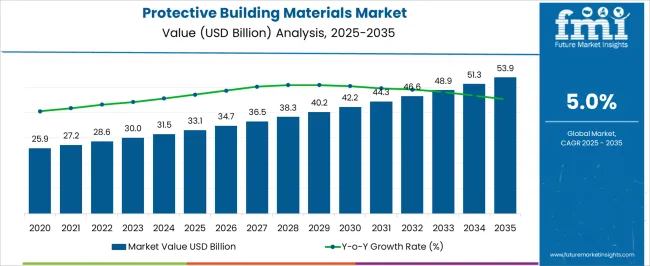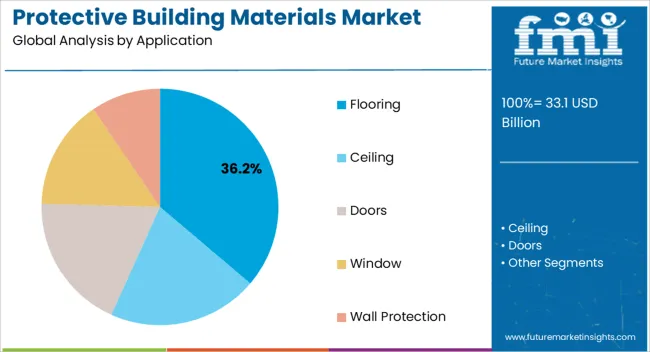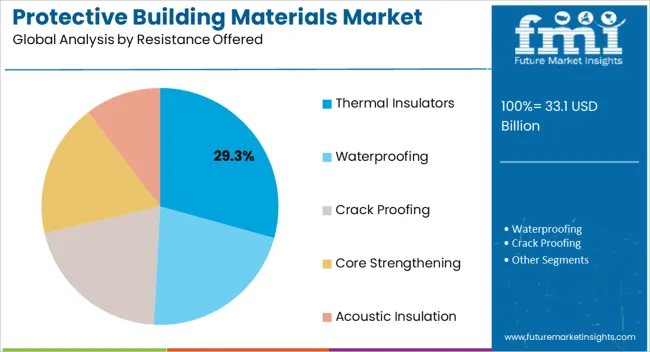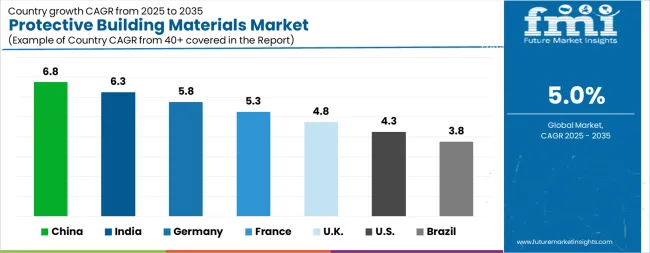The Protective Building Materials Market is estimated to be valued at USD 33.1 billion in 2025 and is projected to reach USD 53.9 billion by 2035, registering a compound annual growth rate (CAGR) of 5.0% over the forecast period.

| Metric | Value |
|---|---|
| Protective Building Materials Market Estimated Value in (2025 E) | USD 33.1 billion |
| Protective Building Materials Market Forecast Value in (2035 F) | USD 53.9 billion |
| Forecast CAGR (2025 to 2035) | 5.0% |
The protective building materials market is experiencing steady expansion, supported by the increasing emphasis on safety, durability, and energy efficiency in modern construction projects. Rising urbanization and infrastructure investments are contributing to higher demand for materials that can withstand environmental stress, improve occupant safety, and extend building lifespans.
The market is being further shaped by evolving regulatory standards that prioritize fire resistance, impact protection, and energy conservation, prompting widespread adoption of advanced protective solutions. Technological advancements in material science are enabling the development of products that combine structural strength with enhanced resistance properties, making them suitable for both residential and commercial applications.
The growing focus on sustainability is also influencing material selection, with manufacturers increasingly investing in eco-friendly production processes and recyclable inputs As construction activity accelerates in emerging economies and renovation projects expand in mature markets, the demand for protective building materials is expected to strengthen, paving the way for long-term market growth supported by regulatory compliance, technological progress, and consumer awareness.
The protective building materials market is segmented by application, material type, resistance offered, form of availability, end-use industry, and geographic regions. By application, protective building materials market is divided into Flooring, Ceiling, Doors, Window, and Wall Protection. In terms of material type, protective building materials market is classified into Metallic, Non-metallic, Composites, and Natural Fibers. Based on resistance offered, protective building materials market is segmented into Thermal Insulators, Waterproofing, Crack Proofing, Core Strengthening, and Acoustic Insulation. By form of availability, protective building materials market is segmented into Sheets, Tiles, Tapes, Fibers, Powders, and Liquids. By end-use industry, protective building materials market is segmented into Commercial, Residential, and Industrial. Regionally, the protective building materials industry is classified into North America, Latin America, Western Europe, Eastern Europe, Balkan & Baltic Countries, Russia & Belarus, Central Asia, East Asia, South Asia & Pacific, and the Middle East & Africa.

The flooring segment is projected to hold 36.2% of the protective building materials market revenue share in 2025, positioning it as the leading application area. This dominance is being driven by the critical role flooring materials play in ensuring safety, durability, and functional performance across residential, commercial, and industrial spaces. Flooring solutions are required to withstand heavy loads, resist wear and tear, and provide resistance against chemical exposure, moisture, and impact.
Increasing demand for high-performance flooring in sectors such as healthcare, hospitality, and manufacturing is supporting sustained adoption. Technological advancements have enabled flooring materials to incorporate protective features such as slip resistance, fire resistance, and easy maintenance, further enhancing their appeal.
The growing focus on occupant safety and compliance with international building codes has made protective flooring materials a priority in construction projects As global urbanization accelerates and building designs prioritize both safety and longevity, the flooring segment is expected to maintain its leadership position in the market, supported by its proven reliability and adaptability.

The metallic material type segment is anticipated to account for 40.1% of the protective building materials market revenue share in 2025, making it the leading material type. This leadership is being reinforced by the inherent strength, durability, and versatility of metallic materials, which make them indispensable for structural reinforcement, protective cladding, and high-stress applications. Metallic solutions offer superior resistance to impact, fire, and wear, ensuring long service life and reduced maintenance requirements.
Their widespread use in commercial and industrial buildings, as well as in infrastructure projects such as bridges and high-rise structures, is contributing to continued demand. Advances in surface treatment technologies are enhancing corrosion resistance and enabling metallic materials to perform effectively in harsh environmental conditions.
Additionally, the recyclability and sustainability benefits of metals are aligning with the global push toward eco-friendly construction practices As construction projects increasingly prioritize long-term durability, safety, and environmental responsibility, metallic materials are expected to remain the most widely adopted type within the protective building materials market.

The thermal insulators segment is expected to represent 29.3% of the protective building materials market revenue share in 2025, making it the leading category based on resistance offered. Its growth is being supported by the rising importance of energy efficiency, climate control, and occupant comfort in building design. Thermal insulating materials reduce energy consumption by maintaining stable indoor temperatures, directly contributing to lower operational costs and compliance with international energy efficiency standards.
Increasing government regulations mandating improved building insulation, particularly in Europe, North America, and rapidly urbanizing regions of Asia-Pacific, are accelerating adoption. In addition to energy conservation, thermal insulators enhance fire resistance and improve the overall safety profile of buildings, making them a critical component of modern protective construction strategies.
Growing awareness of sustainable living and the need to reduce greenhouse gas emissions are further influencing demand As developers and consumers prioritize eco-friendly and cost-effective building solutions, the thermal insulators segment is expected to remain at the forefront of market growth, supported by technological advancements and policy-driven adoption.
The construction industry has witnessed highest growth rate in past decades. This has enforced the industries to adopt new technologies in construction so as to ensure their position in the global market. Increasing competition and modernizing standards of civil engineering has increased the demands of protective building materials.
Protective building materials are the materials which are added on to enhance the endurance of the structure to survive under various conditions. Protective building materials not only provide extra strength, but also improves the life of the structure. Protective building materials are available in different forms, which can be mixed while construction or can be applied later on.
Protective building materials are generally used to assure resistance against corrosion, fire, radiations, seepage, tremors and physical damages. Protective building materials may involve high grade composite steels, cements and additives, paints, floorings, panels, sheets, liquids and various tapes. In general, composite materials and non-metals are used as protective building materials due to their favorable properties like thermal insulation, hydrophobic nature, flexibility and hardness.

| Country | CAGR |
|---|---|
| China | 6.8% |
| India | 6.3% |
| Germany | 5.8% |
| France | 5.3% |
| UK | 4.8% |
| USA | 4.3% |
| Brazil | 3.8% |
The Protective Building Materials Market is expected to register a CAGR of 5.0% during the forecast period, exhibiting varied country level momentum. China leads with the highest CAGR of 6.8%, followed by India at 6.3%. Developed markets such as Germany, France, and the UK continue to expand steadily, while the USA is likely to grow at consistent rates. Brazil posts the lowest CAGR at 3.8%, yet still underscores a broadly positive trajectory for the global Protective Building Materials Market. In 2024, Germany held a dominant revenue in the Western Europe market and is expected to grow with a CAGR of 5.8%. The USA Protective Building Materials Market is estimated to be valued at USD 12.4 billion in 2025 and is anticipated to reach a valuation of USD 18.8 billion by 2035. Sales are projected to rise at a CAGR of 4.3% over the forecast period between 2025 and 2035. While Japan and South Korea markets are estimated to be valued at USD 1.7 billion and USD 939.5 million respectively in 2025.

| Item | Value |
|---|---|
| Quantitative Units | USD 33.1 Billion |
| Application | Flooring, Ceiling, Doors, Window, and Wall Protection |
| Material Type | Metallic, Non-metallic, Composites, and Natural Fibers |
| Resistance Offered | Thermal Insulators, Waterproofing, Crack Proofing, Core Strengthening, and Acoustic Insulation |
| Form of Availability | Sheets, Tiles, Tapes, Fibers, Powders, and Liquids |
| End-Use Industry | Commercial, Residential, and Industrial |
| Regions Covered | North America, Europe, Asia-Pacific, Latin America, Middle East & Africa |
| Country Covered | United States, Canada, Germany, France, United Kingdom, China, Japan, India, Brazil, South Africa |
| Key Companies Profiled | BASF SE, 3M, Knauf Insulation, Trelleborg AB, Owens Corning, Sika AG, DuPont, Cymat Building Materials, CBC Group, and K. Wah Group |
The global protective building materials market is estimated to be valued at USD 33.1 billion in 2025.
The market size for the protective building materials market is projected to reach USD 53.9 billion by 2035.
The protective building materials market is expected to grow at a 5.0% CAGR between 2025 and 2035.
The key product types in protective building materials market are flooring, ceiling, doors, window and wall protection.
In terms of material type, metallic segment to command 40.1% share in the protective building materials market in 2025.






Our Research Products

The "Full Research Suite" delivers actionable market intel, deep dives on markets or technologies, so clients act faster, cut risk, and unlock growth.

The Leaderboard benchmarks and ranks top vendors, classifying them as Established Leaders, Leading Challengers, or Disruptors & Challengers.

Locates where complements amplify value and substitutes erode it, forecasting net impact by horizon

We deliver granular, decision-grade intel: market sizing, 5-year forecasts, pricing, adoption, usage, revenue, and operational KPIs—plus competitor tracking, regulation, and value chains—across 60 countries broadly.

Spot the shifts before they hit your P&L. We track inflection points, adoption curves, pricing moves, and ecosystem plays to show where demand is heading, why it is changing, and what to do next across high-growth markets and disruptive tech

Real-time reads of user behavior. We track shifting priorities, perceptions of today’s and next-gen services, and provider experience, then pace how fast tech moves from trial to adoption, blending buyer, consumer, and channel inputs with social signals (#WhySwitch, #UX).

Partner with our analyst team to build a custom report designed around your business priorities. From analysing market trends to assessing competitors or crafting bespoke datasets, we tailor insights to your needs.
Supplier Intelligence
Discovery & Profiling
Capacity & Footprint
Performance & Risk
Compliance & Governance
Commercial Readiness
Who Supplies Whom
Scorecards & Shortlists
Playbooks & Docs
Category Intelligence
Definition & Scope
Demand & Use Cases
Cost Drivers
Market Structure
Supply Chain Map
Trade & Policy
Operating Norms
Deliverables
Buyer Intelligence
Account Basics
Spend & Scope
Procurement Model
Vendor Requirements
Terms & Policies
Entry Strategy
Pain Points & Triggers
Outputs
Pricing Analysis
Benchmarks
Trends
Should-Cost
Indexation
Landed Cost
Commercial Terms
Deliverables
Brand Analysis
Positioning & Value Prop
Share & Presence
Customer Evidence
Go-to-Market
Digital & Reputation
Compliance & Trust
KPIs & Gaps
Outputs
Full Research Suite comprises of:
Market outlook & trends analysis
Interviews & case studies
Strategic recommendations
Vendor profiles & capabilities analysis
5-year forecasts
8 regions and 60+ country-level data splits
Market segment data splits
12 months of continuous data updates
DELIVERED AS:
PDF EXCEL ONLINE
Protective Glove Market Forecast Outlook 2025 to 2035
Protective Film Market Size and Share Forecast Outlook 2025 to 2035
Protective Earth Resistance Meter Market Size and Share Forecast Outlook 2025 to 2035
Protective Wrapping Paper Market Size and Share Forecast Outlook 2025 to 2035
Protective Mask Market Size and Share Forecast Outlook 2025 to 2035
Protective Packaging Market Analysis - Size, Share, and Forecast Outlook 2025 to 2035
Protective Packaging Industry Analysis in United States and Canada - Size, Share, and Forecast 2025 to 2035
Protective Clothing Market - Trends, Growth & Forecast 2025 to 2035
Protective Eyewear Market Trends – Industry Growth & Forecast 2025 to 2035
Market Share Distribution Among Protective Packaging Manufacturers
Market Share Insights of Leading Protective Textiles Providers
Protective Relay Market
Protective Footwear Market
Protective Films Tapes Market
Protective Goggles Market
Protective Gowns Market
ESD Protective Signage Labels Market Size and Share Forecast Outlook 2025 to 2035
Fire Protective Materials Market Size and Share Forecast Outlook 2025 to 2035
Sports Protective Equipment Market Size and Share Forecast Outlook 2025 to 2035
Medical Protective Equipment Market - Growth, Innovations & Forecast 2025 to 2035

Thank you!
You will receive an email from our Business Development Manager. Please be sure to check your SPAM/JUNK folder too.
Chat With
MaRIA